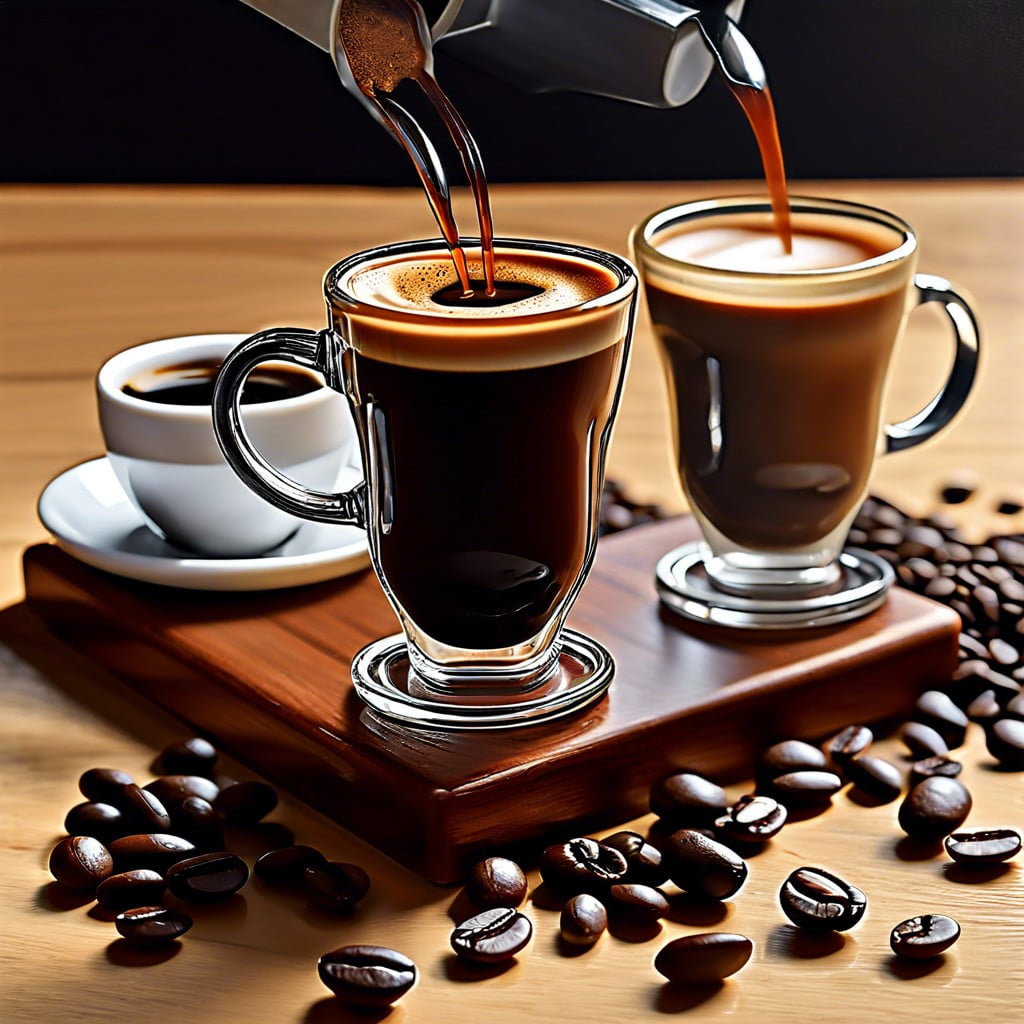Discover what drip coffee is, how it’s made, and why it’s a beloved staple in coffee culture.
Difference Between Espresso and Drip Coffee

Drip coffee and espresso may come from the same beans, but they’re like distant cousins rather than siblings. Think of espresso as the intense, somewhat high-strung member of the family. It’s made by forcing hot water through finely-ground coffee with significant pressure, resulting in a concentrated shot of java with a velvety crema on top. Speed is of the essence here – an espresso is to coffee what a sprint is to running, quick and powerful.
Drip coffee, on the flip side, is the laid-back cousin. It takes its sweet time, using gravity rather than pressure. Water meanders through coarser grounds, picking up flavors and compounds en route to your mug. The result is a milder, often more nuanced cup, that’s ready to accompany you through your morning routine or a long chat with an old friend. This method is marathon coffee, emphasizing endurance over intensity.
Each method has its rituals and fans, and no one’s in a hurry to pick sides. Sure, espresso gives that instant jolt, but drip coffee? It invites you to linger a little longer.
Drip Coffee Brewing Process
Imagine your coffee maker at home, diligently working to gift you that cherished morning cup. This magic happens through a simple, yet effective process. Water heated up to just shy of boiling cascades over your favorite coffee grounds. Nestled in a filter, these grounds eagerly await to surrender their flavors. As water permeates through, it extracts the coffee’s oils and essences. This liquid treasure then drips down, obedient to gravity, into a carafe or mug, ready for your enjoyment.
Precision in water temperature matters; too hot, and your coffee is bitter, too cool, and it’s under-extracted. The drip method marries time and temperature to achieve a balanced brew. It’s a patient rendezvous between water and coffee grounds, typically lasting several minutes. The resulting beverage is both clear and clean-tasting, due to the filter catching most oils and fine particles. Keep in mind, finer grinds necessitate a slower water flow for full flavor extraction without over-extraction.
In essence, this method’s beauty lies in its ability to consistently produce a solid cup of coffee with minimal fuss. Just ensure the coffee grounds are spread evenly for an even extraction, and you’re set. After all, there’s something comforting about the rhythmic drip and the warm scent of coffee filling the room—it’s like a morning ritual that signals a fresh start.
Ground Coffee and Grind Size
Selecting the appropriate grind size can make or break your drip brew. Think of it like choosing the right gear on a bike; too high and you can barely move forward, too low and you’re pedaling like mad but going nowhere fast. For drip coffee, a medium grind typically does the trick. This texture resembles sea salt, which allows water to flow through at a steady pace, extracting flavors thoroughly.
If the grounds are too fine, the coffee can taste over-extracted, bitter, and harsh – as if it’s throwing a tantrum on your taste buds. On the flip side, too coarse a grind may result in a weak, underwhelming cup, akin to attending a concert where the band forgot to turn on their amps. It’s all about balance.
Also, ensure your coffee is ground fresh. Why? Grinding coffee is like unlocking a flavor treasure chest, but those flavors start to escape the moment you grind. Using freshly ground coffee gives your morning cup that rich aroma and full-bodied taste that can turn a mundane morning into a mini-celebration.
Consistency and Quality
To brew a cup that hits the spot every time, precision is your best friend. Think of consistency as the dependable buddy ensuring each sip is as satisfying as the last. This starts with water temperature; too hot, and you’ll burn your grounds. A little too cool, and the flavors won’t fully unfold. Aim for about 195 to 205 degrees Fahrenheit to be in the goldilocks zone for extraction.
Next, there’s the grind. A coarse sand texture is just right for drip coffee. Too fine, and you might find yourself with a bitter brew; too coarse, and the coffee can turn out weak. Keep the quality of your coffee high by storing beans properly – away from light, heat, and strong odors, and in an airtight container.
Remember, water quality can’t be overlooked. Hard water can lead to buildup in your machine and affect the taste. Soft, filtered water usually does the trick, helping those taste notes shine.
A consistent brew time matters, too. Rush it or drag it out, and you won’t be doing justice to those carefully selected beans. Most machines take about 5 minutes, but watch the clock to maintain the rhythm.
Lastly, cleanliness is a silent hero. Oils and residues can play spoiler. Keep your equipment spick and span to ensure the intrinsic coffee flavors aren’t muddled.
Coffee Preparation and Recipes
Crafting the perfect cup of drip coffee isn’t just a matter of pouring water over grounds. The devil is in the details.
First, the water temperature is vital—aim for about 195°F to 205°F. Too hot, and your coffee is scorched; too cool, and it’s under-extracted.
The ratio of water to coffee also plays a pivotal role. A standard guideline is 1 to 2 tablespoons of ground coffee for every 6 ounces of water, but feel free to tweak to taste.
Next, consider the bloom. Wet the grounds and give them 30 seconds to swell and release those delicious, trapped gases for a full-bodied flavor.
Finally, don’t rush the drip. A slower infusion means a richer brew. Some machines let you adjust the flow rate, so experiment to find your sweet spot.
Remember, consistency is key—recreate the steps for each pot. Whether you prefer a bright, eye-opening blend or a smooth, contemplative sip, a precise approach will elevate your home brew. Happy brewing!